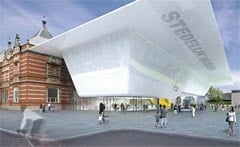This is nothing to do with stone directly, but as composite materials are increasingly competing with natural stone we thought you might be interested to see the Stedelijk Museum in Amsterdam. It is currently under construction but will emerge as the largest composite-clad building in the world.
The new face of the Stedelijk Museum is becoming more noticeable by the day. A large proportion of the panels are in place on what is already being called 'The Bathtub'.
The designers believe the bright and seemingly floating construction with its sleek, seamless finish will be the perfect foil to the adjacent historic brick building from 1895.
The Japanese fibre manufacturers Teijin produced and donated the Twaron (aramid fiber) and Tenax (carbon fiber) for the composite used to create the façade. This, along with a substantial financial contribution, makes Teijin one of the main founders of the new Stedelijk Museum.
The façade was designed by BenthemCrouwel Architects. It consists of a single surface and covers an area of about 3,000m2. To achieve that without expansion joints engineering firm Solico devised a sandwich construction. It has an inner skin and outer skin of a composite laminate of resin, strengthened by Twaron and Tenax fibres. The resin expands as the temperature rises but both Twaron and Tenax have a negative longitudinal thermal expansion coefficient, counteracting the expansion of the resin.
The result is a composite panel with minimal thermal expansion. For each 100m of facade it expands by only 1mm per degree Celsius temperature rise. A fiberglass composite or aluminum façade would expand about 2.5 times more.
For the production of the panels, Teijin supplied the fibres to Holland Composites. A unidirectional fabric was produced as an intermediate product used in the panels with vinylester resin and a PIR foam core. The inner skin and outer skin of the sandwich construction consist of two Twaron fabrics with a Tenax fabric in between. The fibers are perpendicularly oriented to each other.In all, the façade consists of 271 loose elements containing 4,850kg of Twaron and 4,050kg of Tenax.
The panels are mounted on site and glued together using a connecting laminate to form a single unit.
Teijin, and the Netherlands-based Teijin Aramid with its headquarters in Arnhem, made a tremendous gesture towards the Netherlands and the Stedelijk Museum by providing both the materials and significant funds for the project.

